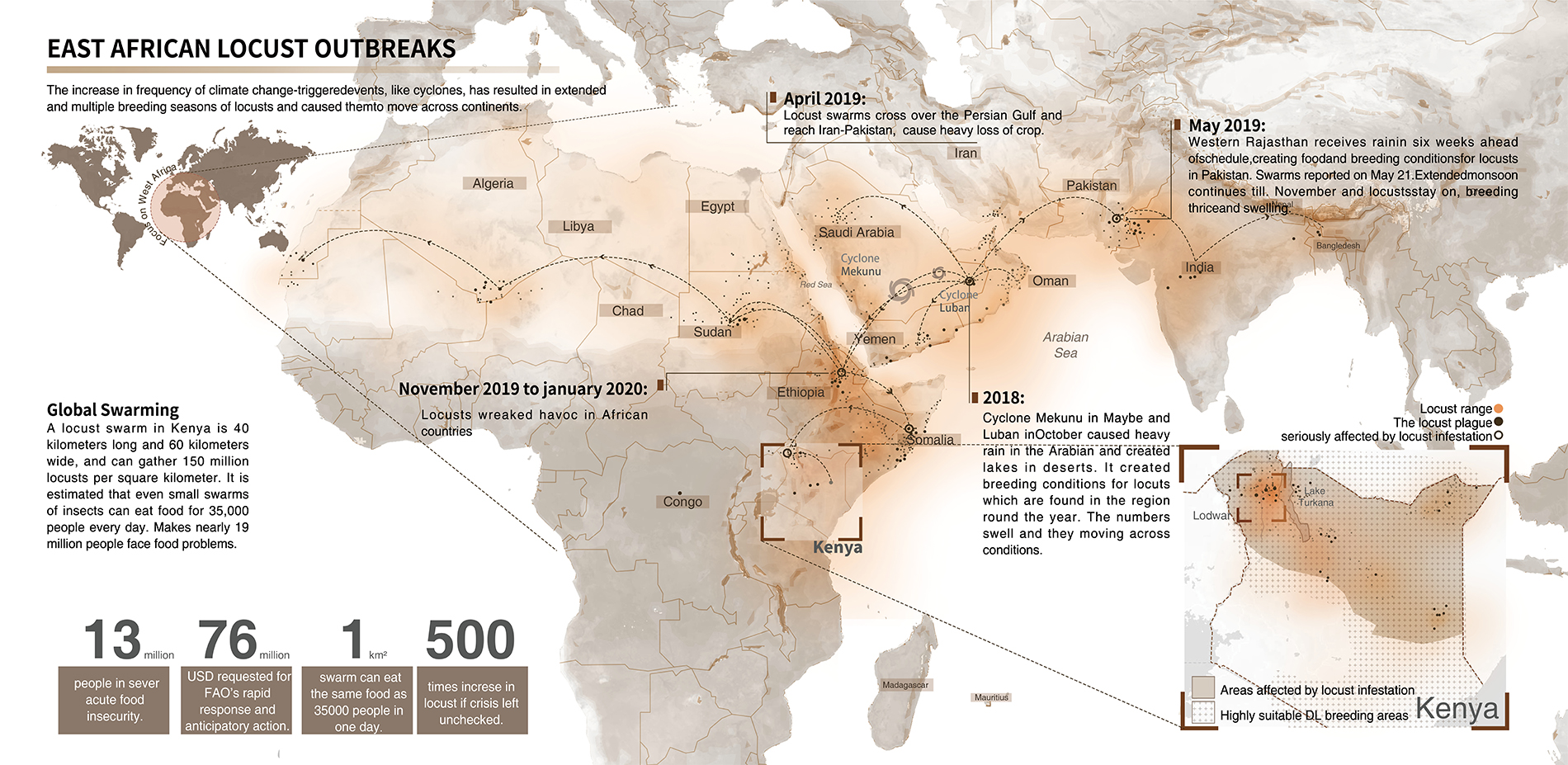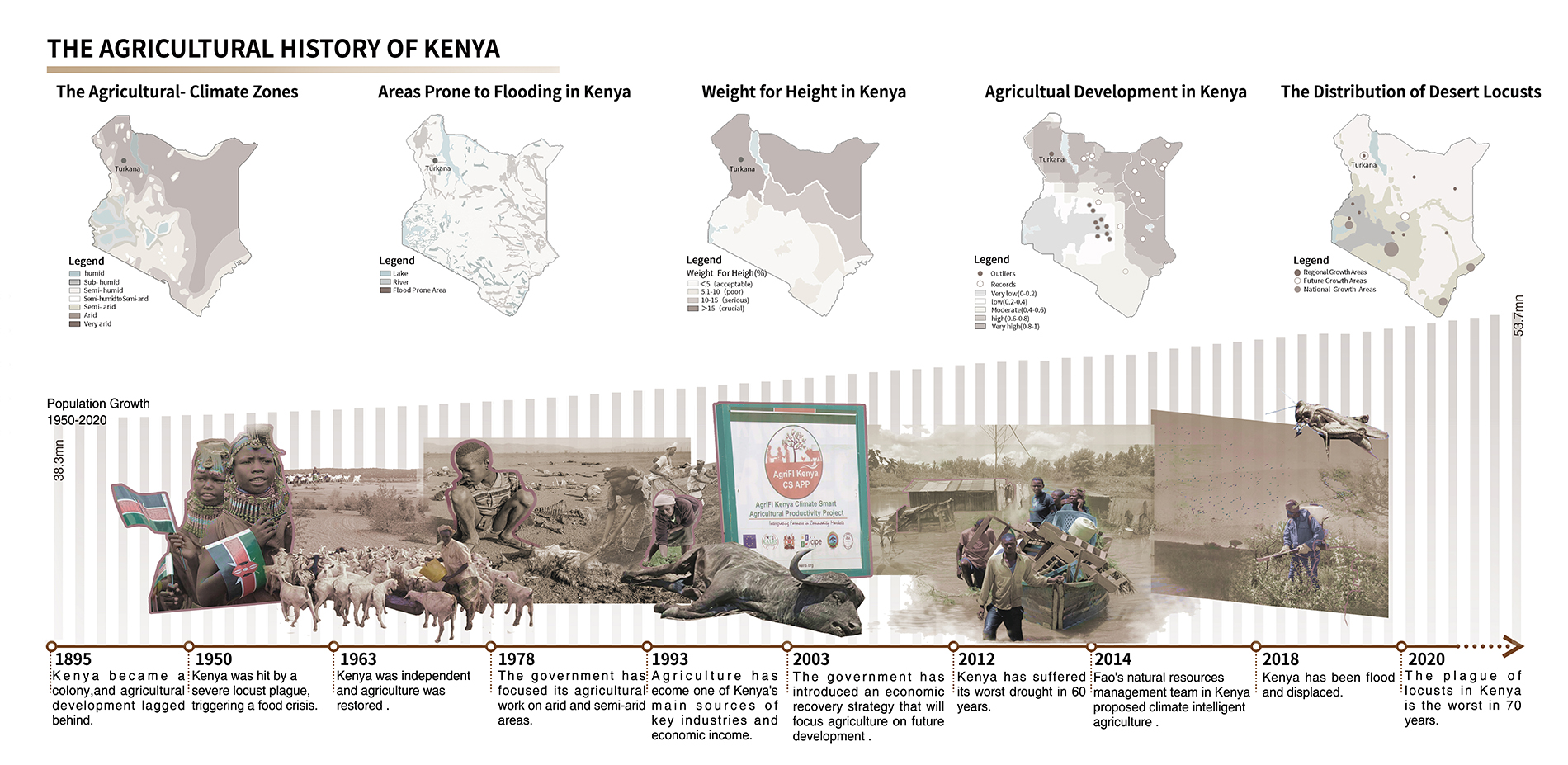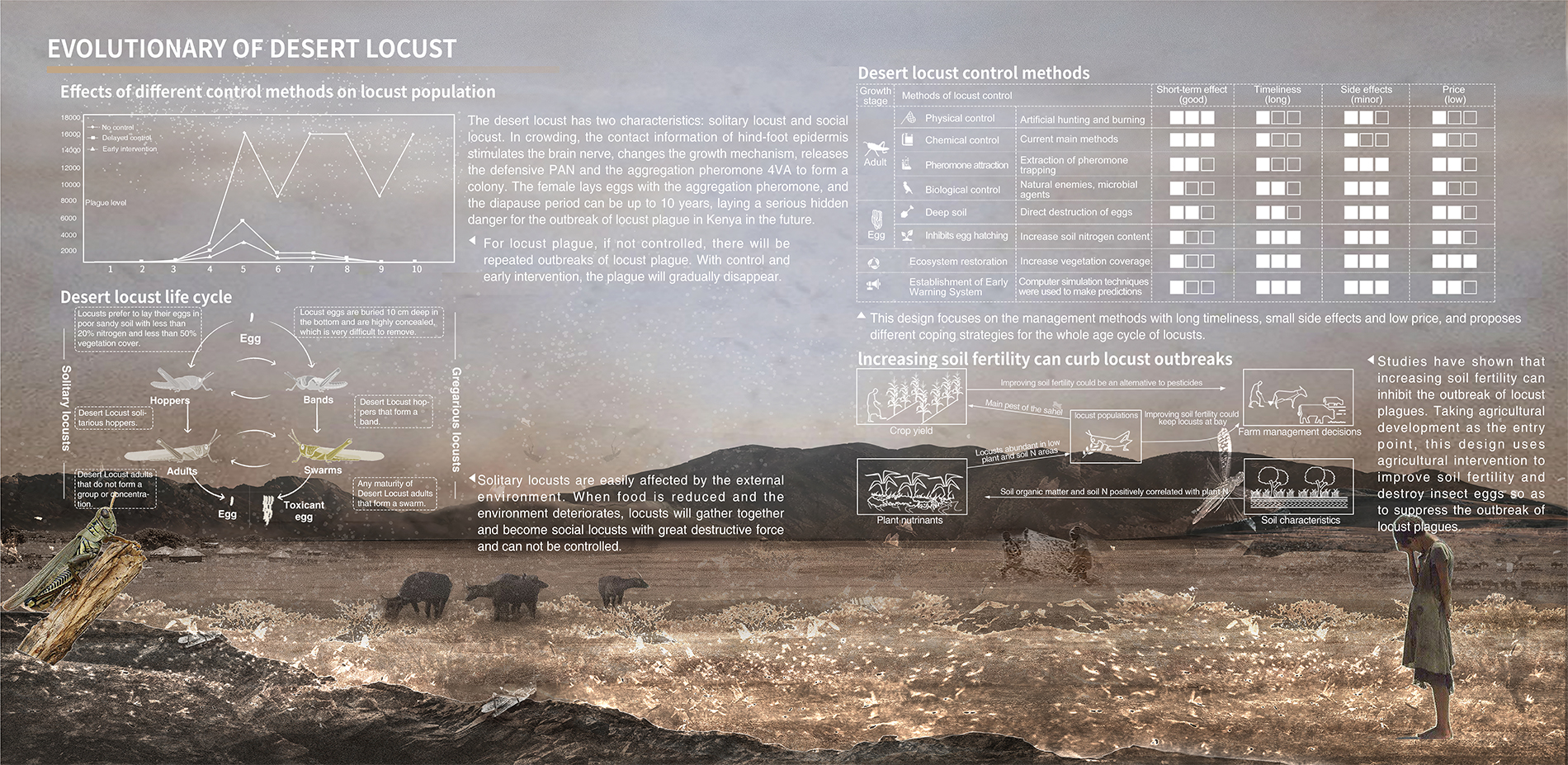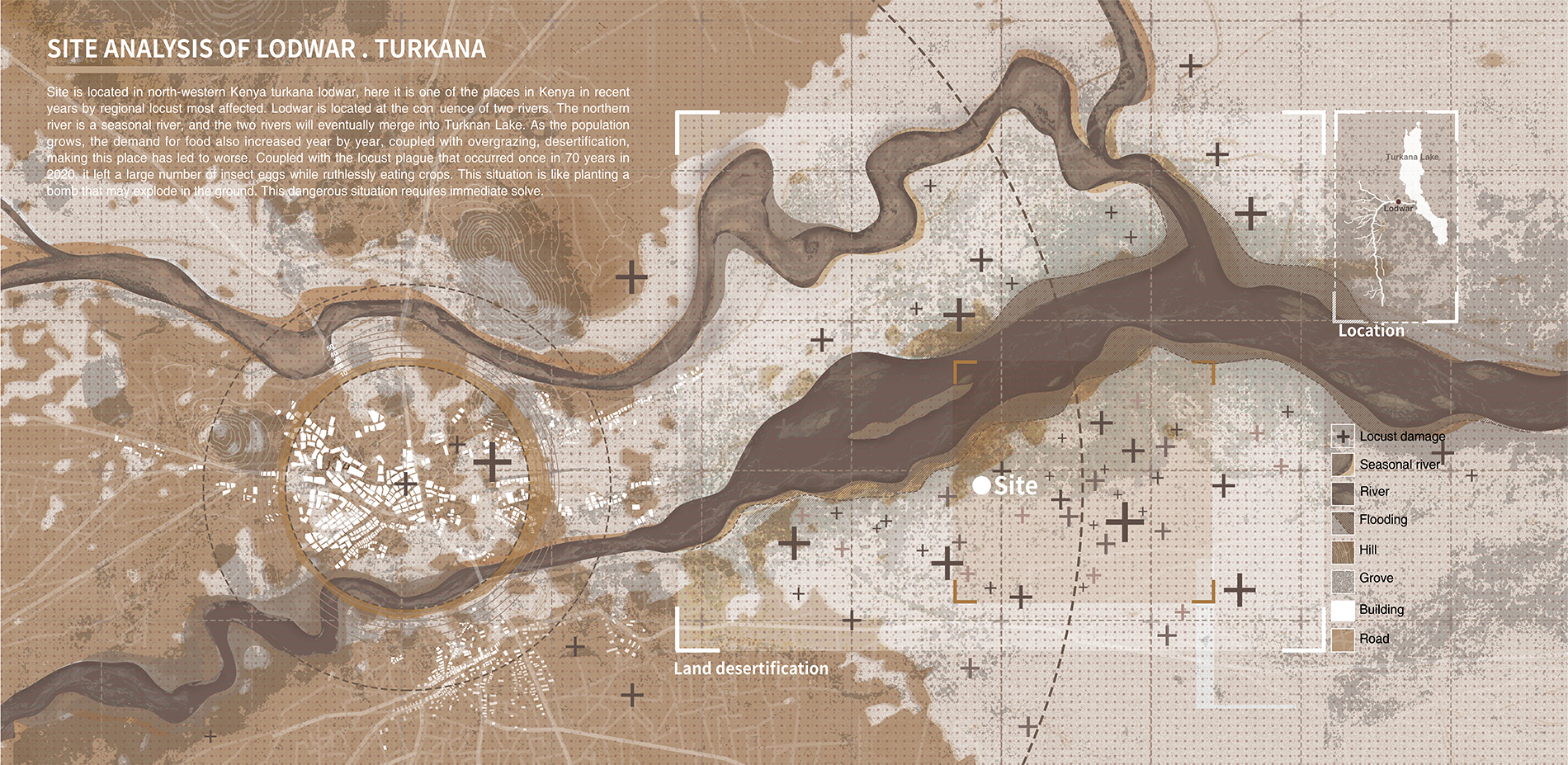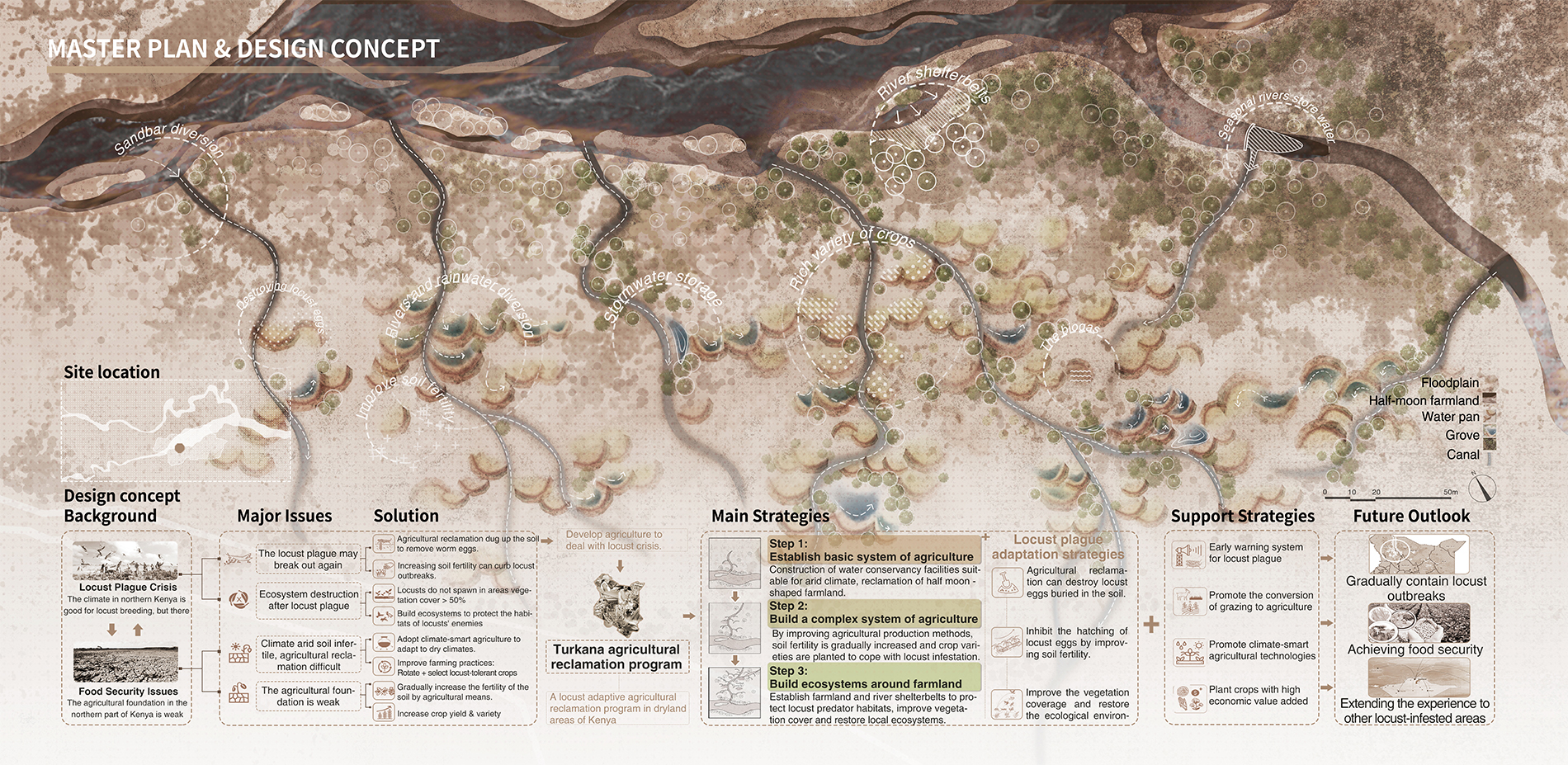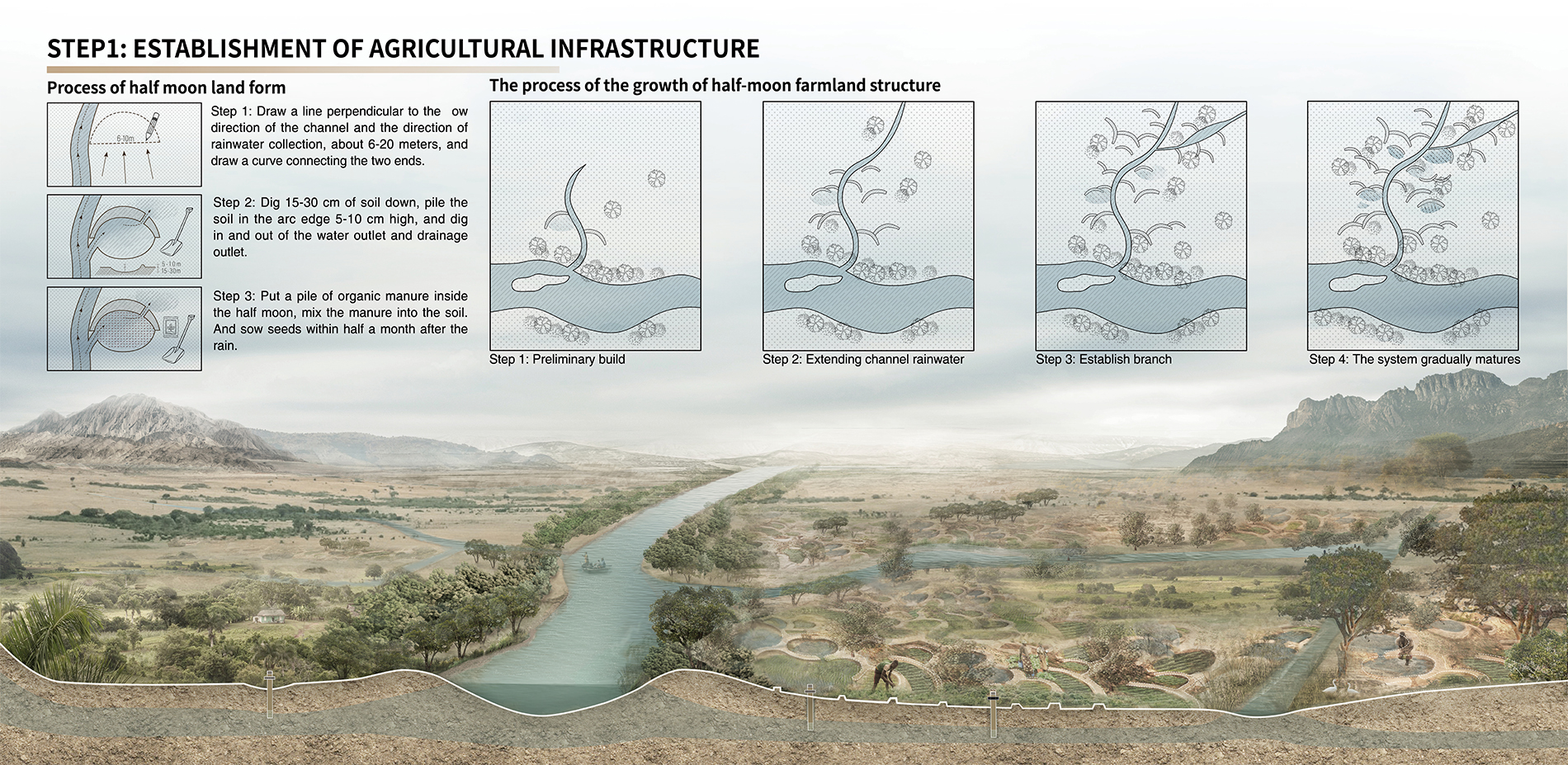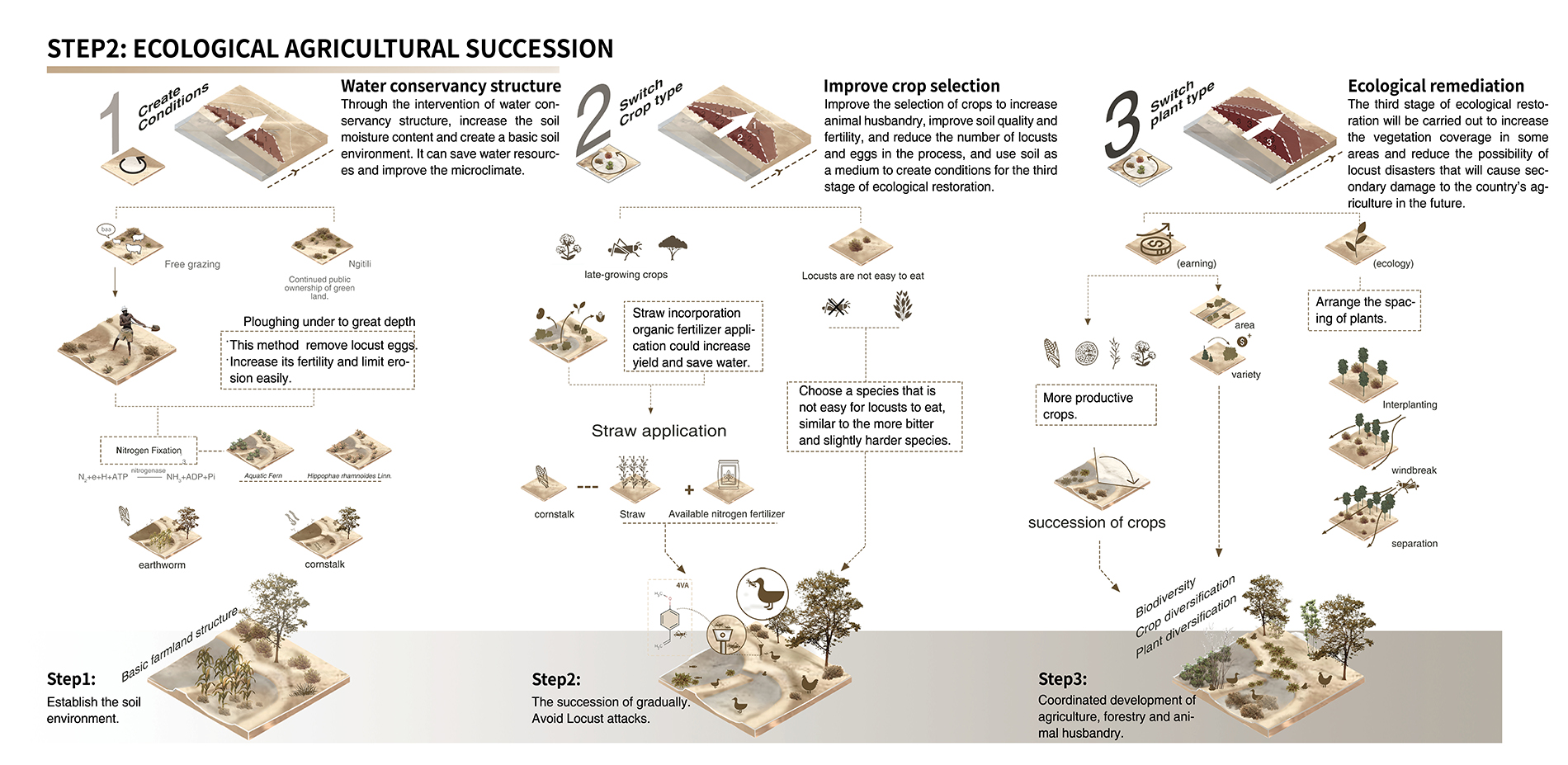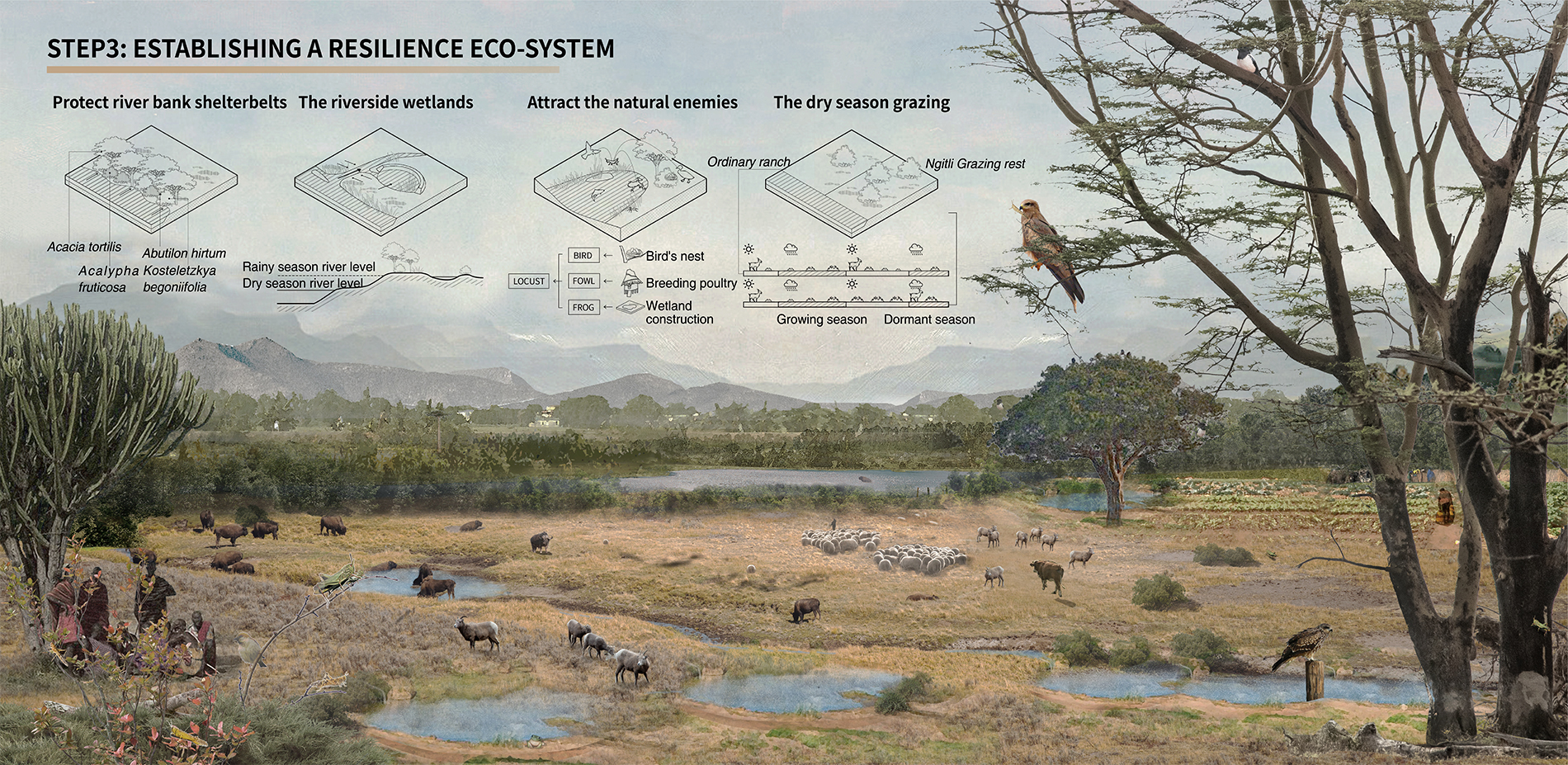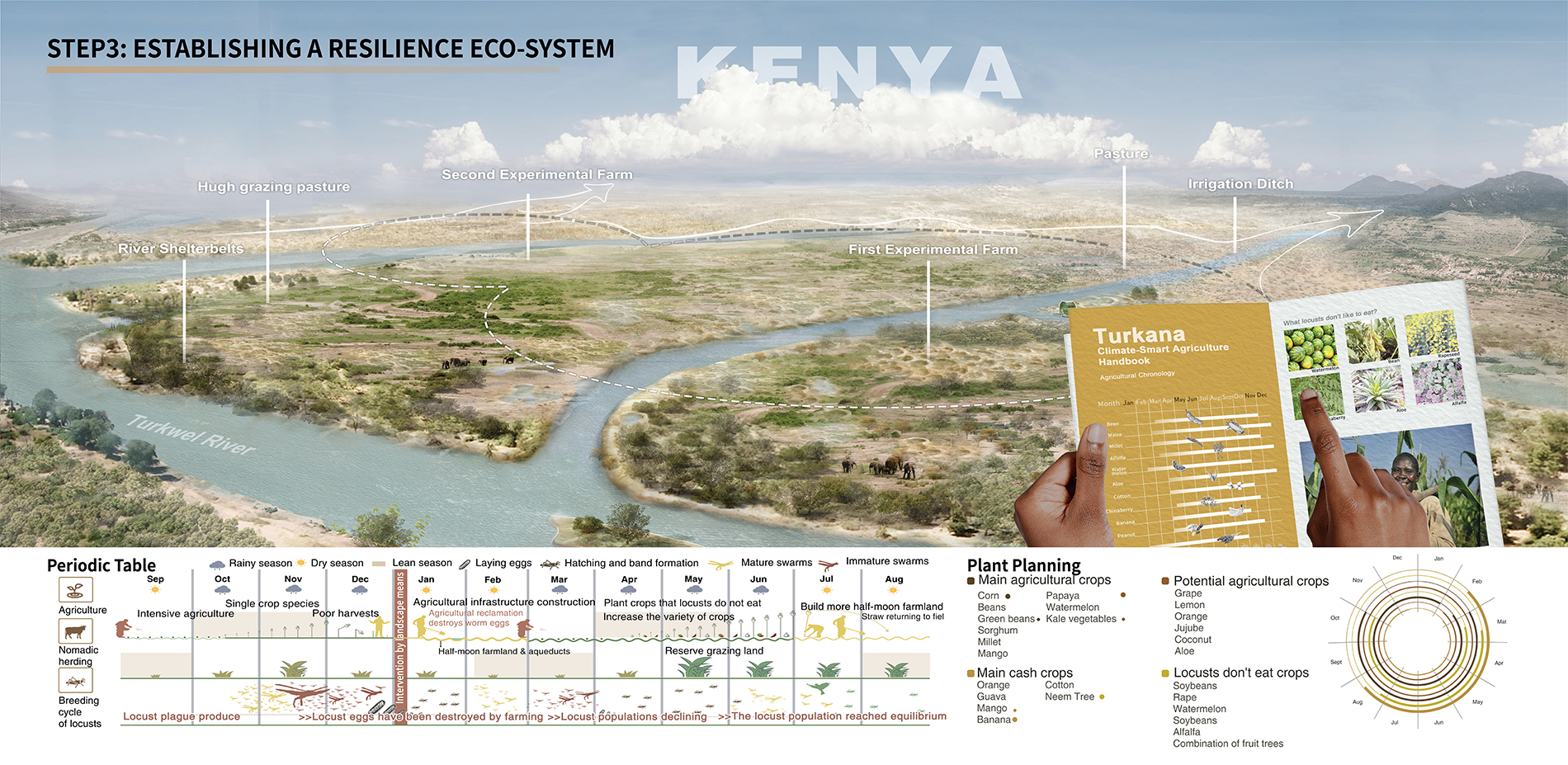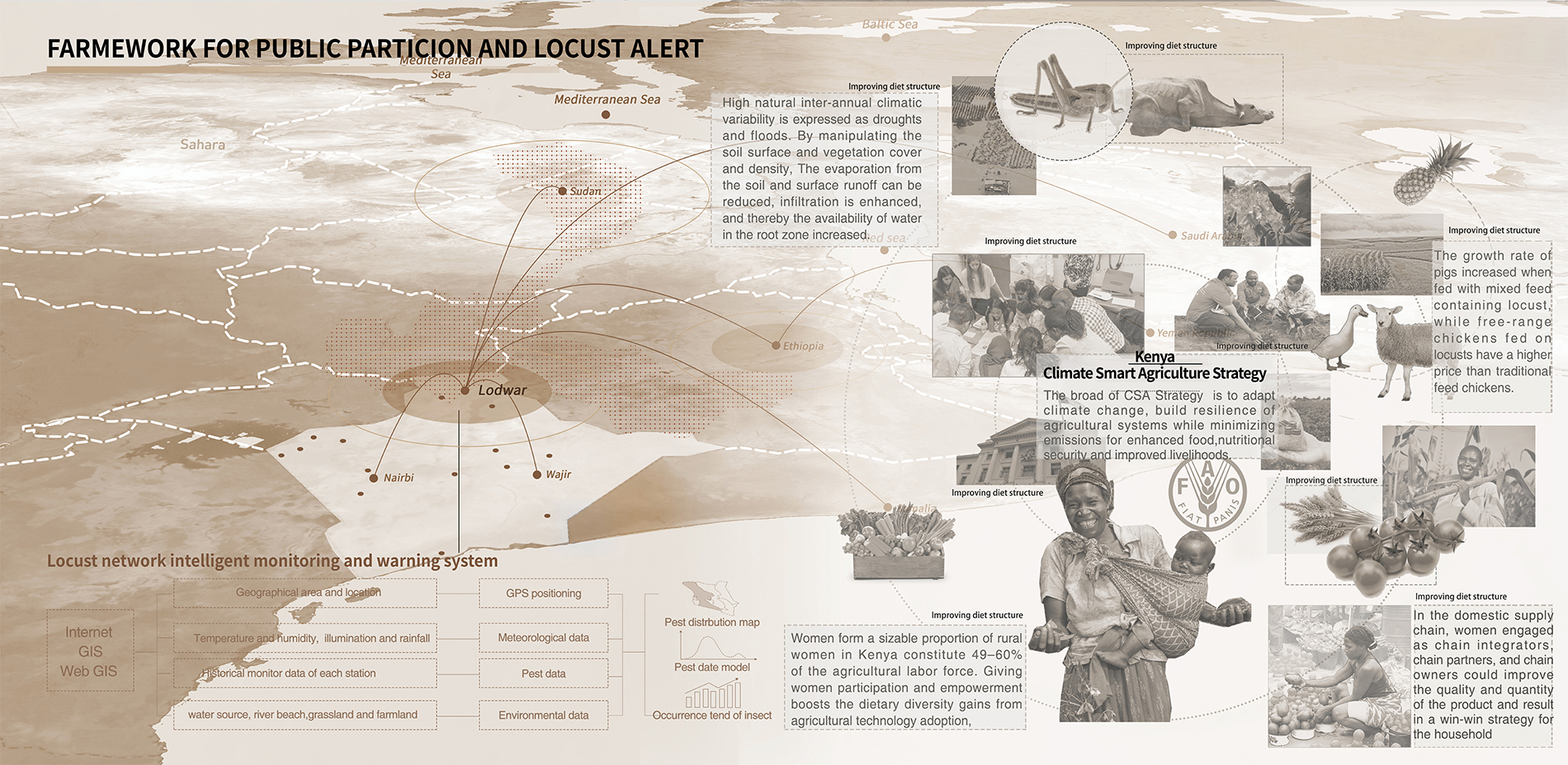A New Solution Based on Locust Outbreak
Honor Award
Analysis and Planning
Lodwar, Kenya
Chaoqun Lin, Student ASLA; Zhen Hu; Ying Luo; Shengxu Zhao; Hongchao Xin; Yu Zhang
Faculty Advisors: Joseph Ewan, ASLA; Xiaoming Liu; Weimin Guo
Arizona State University
Beijing Forestry University
Jiangnan University
With an in-depth analysis of locust infestations in Kenya, this project is an excellent study of regenerative agriculture. The issue is well-researched, and we were surprised as to just how much we learned from their work, as well as how feasible and appropriate their solution is. We believe that this plan could easily be implemented, and we appreciate that they took into account community engagement, which is often neglected in projects like this.
- 2021 Awards Jury
Project Statement
In 2020, Kenya suffered a once-in-70-year locust plague. The locusts caused heavy losses in Kenya, where agriculture is a pillar industry, and a large number of people died of famine and poverty. The "World Food Security and Nutrition Report 2020" pointed out that nearly 690 million people will go hungry in 2019, and several East African countries in the Red Sea with agriculture as the main pillar industry are facing persistent locusts while a large number of people are dying. disaster. Although locusts are natural disasters, a large part of the reason is attributed to Kenya's extensive agricultural model (in order to expand production at will), which results in insufficient surface vegetation coverage, giving locusts a large number of opportunities to lay eggs (vegetation coverage is less than 35%). Plan: Through locust habits, use landscape techniques to intervene in Kenya's agricultural structure and the grazing sequence of animal husbandry, and use production economy as a link to improve soil structure to restore Kenya's vegetation coverage and ecology. Locust invasion, food famine, humanitarian care.
Project Narrative
In 2020, Massive locust outbreaks threatened the terrestrial environments and crop production in around 100 countries where Ethiopia, Somalia, and Kenya are the most affected. The locust invasion has left farmers in resource-poor countries to count crop losses but struggles with emerging environmental and health problems. In February 2020, Kenya's local media reported that a swarm covering
2,400 sq km (930 sq miles) was recorded in northern, the largest on record. The locust invasion swept over farms in rural Kenya and causing the loss of pastures, vegetation, and livestock. Due to the locusts, The swarms have been the worst seen in Kenya for over 70 years. Extensive agriculture leads to insufficient surface vegetation coverage, while the instability of monsoon and rainfall is caused by the abnormal climate of El Nino, which hurts Kenya's agriculture resilience.
Desert locusts (Schistocerca gregaria) have been called the most devastating pest. Swarms form when locusts' numbers increase, and they become crowded. This causes a switch from a relatively harmless solitarious phase to a gregarious phase. In this phase, the insects can multiply 20-fold in three months and reach 80 million per square kilometer densities.
The design focuses on locust's full cycle, dampens the locusts' swarming cycle, and keeps locusts in solitary phase to maintain locust populations. Since preventing all outbreaks and upsurges is not possible, this level of prevention would require teams to find and treat virtually all small gregarious populations present as the first outbreaks form following widespread rains. It might also be tempting to treat large areas of locusts that are at less than a band or swarm density to prevent attacks. Such treatments would not be economically or environmentally sound, nor would they add significantly to the total number of locusts controlled.
By targeting the months when locusts are prone to outbreaks. First, Plant leguminous and melon crops that locusts don't like to eat, such as soybean, grape, and watermelon, which could help prevent locust outbreaks and obtain food diversity for local people. And plant crops with high nitrogen content. Second, Planting plants at intervals between the fields prevents weeds from occupying the nutrients of the crops. Third. The half-moon-shaped pit is made into a natural biogas digester, and biological fertilizer is returned to the field. The design improving the soil's richness, forestation, micro-climate, and bio-diversity comes while the land's richness has improved. These practices are conducive to increasing the land's nitrogen content and the greening rate, which are factors that inhibit locusts.
The site is located on the outskirts of Lodwar City in Turkana, northwestern Kenya, One of the potential lands in the national smart agriculture growing area. Turkwel River runs through the center of the site. Due to the over-grazing and extensively managed agricultural system brought about by population growth in recent years, the local ecological environment has degraded, and land desertification has intensified. At the same time, this is one of the areas most severely affected by locust plagues in Kenya in recent years. Due to the preference of locusts for soil quality and soil water content, a large number of insect eggs are retained at the junction of the Turkwel River forest belt and desert, as if buried in the ground. Bombs that may explode soon, these crises have become urgent problems that need to be resolved now.
The innovative new agricultural system based on the indenes wisdom half-moon cropland, with further remodification which could reduce the evaporation of runoff, increases the utilization rate of water resources by intercepting the lower reaches of the Tukana River and cooperates with Kenya's climate smart agriculture policy to improve food security and improve local nutrition problems effectively. With the method of half-moon unit, water pan, sandbar irrigation ditch can effectively increase the soil's nitrogen content, land's greening rate, and water resources utilization rate. At the source, it can inhibit the production of eggs in this place and divert the possibility of locust colonies. The Soil-targeted interventions with environmental improvement could alleviate locust and grasshopper pest pressure in Kenya.
As part of landscape shaping, It is essential to protect the habitats and biotopes of these natural enemies through, for example, forestation, which combined with late-growing crops such as soybeans, alfalfa, and fruit trees, are efficient measures. With the habitats and biotopes been set up, a resilience eco-system could be created, wasp larvae, mites, spiders, and birds that control outbreaks of up to 90% through predation on larvae and developing locusts. Converting lowland areas into fishpond and shrimp farming is another sustainable way to control locust outbreaks, while bonfires in the dark and burning crops have also been used to eliminate locust pests.
We evaluate the project at three levels. Political: The Government has committed itself to dignify this place and the long and intense participation process that culminates with creating a farmer association hitherto nonexistent. A board with commissions is created to ensure self-management of the irrigated space, establish internal rules, communicate with the city council, visibility of its historical heritage, and the necessary intergenerational transfer of local knowledge. Productive: obtaining clean water allows the practice of organic farming and increases irrigation turns. In the long term, the agriculture growth would ensure this fast-growing state's food security. Civic: promoting recognition, inclusion, and education of the agricultural space.
The innovative irrigation system aims to build a resilient foodscape in east Africa, not only to reduce the impact from locust but also to create a model for other developing countries to ensure food security.
Plant List:
- Main agricultural crops:com、Beans、Green beans、Sorghum、Millet、Mango、Papaya、Watermelon、Kale vegetables
- Potential agricultural crops:Grape、Lemon、Orange、Jujube、Coconut、Aloe
- Main cash crops:Orange、Guava、Mango、Banana、Cotton、Neem Tree
- Locusts don't eat crops:Soybeans、Rape、Watermelon、Soybeans、Alfalfa、Combination of fruit trees
